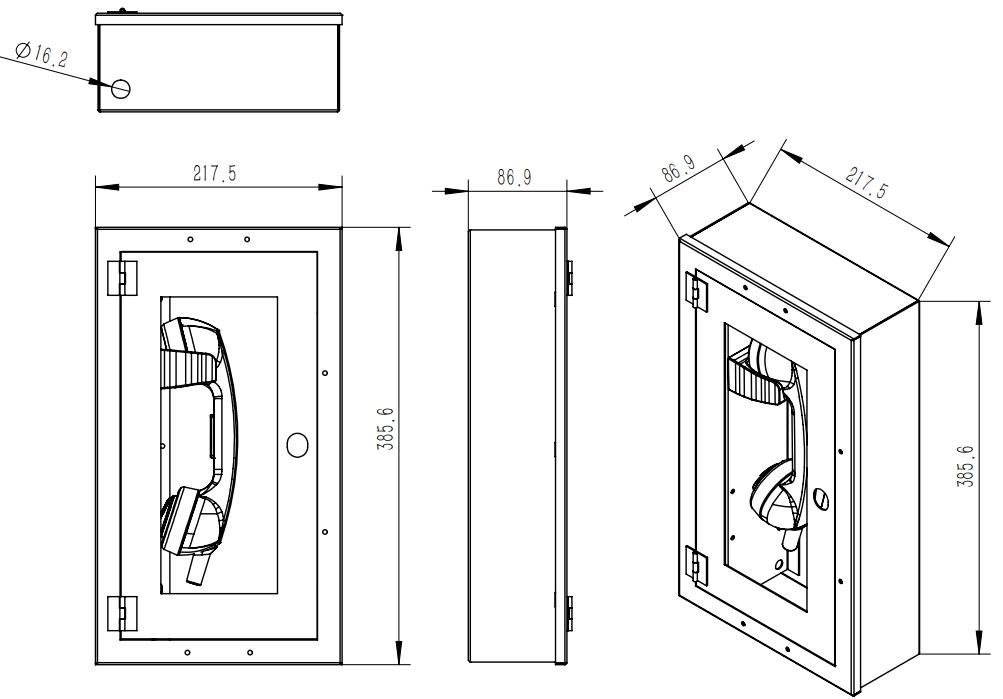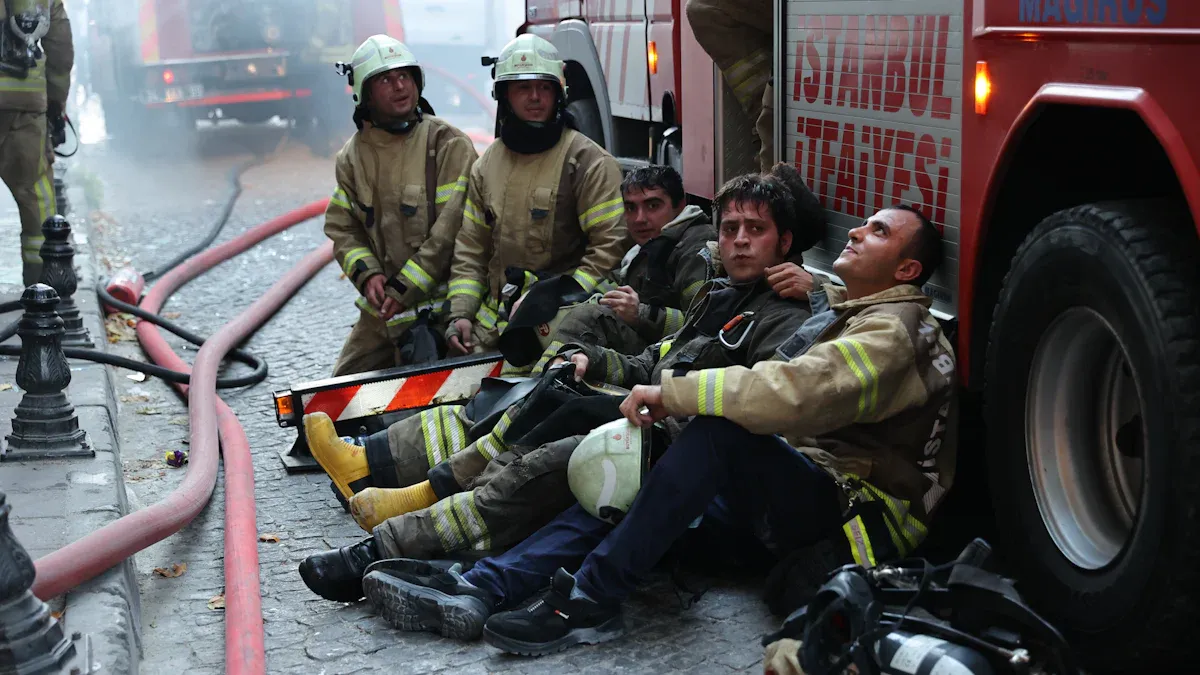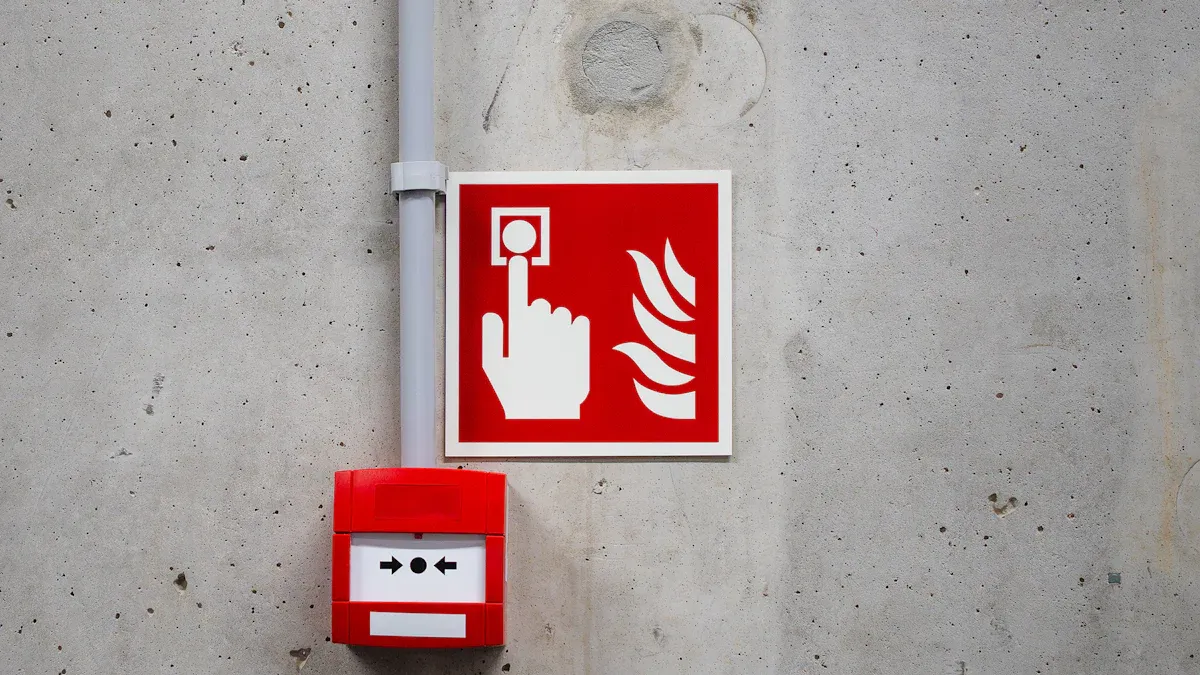
When a fire emergency strikes, clear communication can make all the difference. Chaos and confusion often take over, making it hard for people to act quickly. This is where industrial emergency intercom systems step in. These tools, like an auto dial emergency telephone or a rugged emergency telephone, ensure messages get through. Their industrial heavy duty telephone design keeps them reliable, even in tough conditions.
Common Communication Challenges During Fires

Panic and Stress Among Occupants
During a fire, panic spreads quickly. People often lose their ability to think clearly, which leads to poor decision-making. Stress levels skyrocket, making it harder for individuals to follow instructions or communicate effectively. For example, during the Sonoma County fires in 2018, confusion among alert operators caused delays in issuing warnings. Similarly, the Camp Fire in California revealed how errors in alert systems during high-stress situations can worsen the chaos. These incidents highlight the importance of clear communication tools that can cut through the noise and provide reliable guidance.
Noise and Environmental Disruptions
Fires are loud. Sirens, alarms, and the roar of flames create an overwhelming soundscape. This noise doesn’t just make it hard to hear—it also affects mental health. Studies show that exposure to sirens increases stress by 14% and anxiety by 13%. Firefighters and occupants alike may struggle with cognitive failures, which rise by 57% when noise combines with stress and depression. Industrial Emergency Intercom systems can help by delivering clear, direct messages that cut through the chaos, ensuring everyone stays informed.
Lack of Coordination Between Teams
When teams don’t coordinate, the situation can spiral out of control. Poor communication during the Woolsey Fire led to delayed evacuations, leaving thousands of people stuck in fire-prone areas for hours. In another case, resources were diverted to the nearby Hill Fire, allowing the Woolsey Fire to spread unchecked. These examples show how a lack of coordination can escalate risks. Reliable communication systems, like those used in Industrial Emergency Intercom setups, ensure that teams stay connected and work together effectively.
Benefits of Industrial Emergency Intercoms

Enhanced Clarity and Reliability
Clear communication is essential during emergencies, especially in chaotic environments like fires. Industrial Emergency Intercom systems are designed to deliver dependable communication, even in the most challenging conditions. These systems often include advanced features like noise-canceling technology and echo cancellation, ensuring that every message is heard loud and clear.
For example, many intercoms feature high-quality audio transmission that cuts through background noise, such as sirens or roaring flames. Some models also include an emergency broadcast button, allowing rapid alerts to reach everyone in critical situations. This combination of clarity and reliability ensures that instructions are understood, reducing confusion and improving safety.
| Feature | Description |
|---|---|
| Clear, Reliable Communication | Ensures dependable communication even in challenging environments. |
| Emergency Broadcast | Features an emergency broadcast button for rapid alerts in critical situations. |
Faster Response Times and Coordination
In emergencies, every second counts. Industrial Emergency Intercom systems help teams respond faster and coordinate better. These systems connect key areas of a facility, allowing instant communication between fire marshals, emergency responders, and control rooms.
Several factors contribute to their efficiency:
- Custom intercom solutions improve communication, enabling quick responses and minimizing delays.
- Integration with building management systems ensures seamless operation across different safety tools.
- Advanced technologies, like AI and IoT, enable automated responses and real-time communication, further speeding up decision-making.
By streamlining communication, these intercoms help teams act quickly and work together effectively, reducing risks and saving lives.
Integration with Fire Safety Systems
Industrial Emergency Intercom systems don’t just work alone—they integrate seamlessly with existing fire safety systems. This compatibility ensures a coordinated response during emergencies. For instance, these intercoms can connect with fire alarms, sprinkler systems, and access control tools, creating a unified safety network.
When a fire alarm triggers, the intercom system can automatically activate, allowing immediate communication between critical points. This integration simplifies operations for emergency personnel, ensuring that everyone stays informed and aligned. Facilities that use such interconnected systems experience fewer delays and better overall safety outcomes.
Key Features of Industrial Emergency Intercoms
Durability and Resistance to Harsh Conditions
Fire emergencies often create extreme environments. High temperatures, smoke, and water from sprinklers can damage regular communication devices. Industrial Emergency Intercom systems are built to withstand these challenges. Their rugged construction ensures they remain operational even in the harshest conditions. For example, many models are made from materials like stainless steel or cold-rolled steel, which resist corrosion and physical damage.
These systems also feature weatherproof designs. With waterproof ratings like IP65, they can handle exposure to water, dust, and debris. This makes them suitable for both indoor and outdoor installations. Whether placed in a high-rise building or an open stadium, these intercoms continue to perform reliably. Their durability ensures that communication lines stay open when they’re needed most.
Tip: When choosing an intercom system, look for one with a proven track record of durability. It’s an investment in safety and reliability.
Multi-Channel Communication Capabilities
Emergencies require quick and clear communication between multiple teams. Industrial Emergency Intercom systems excel in this area. They offer multi-channel communication capabilities, allowing different groups to stay connected without interference. For instance, fire marshals can coordinate with control rooms while emergency responders communicate on a separate channel.
This feature eliminates confusion and ensures that everyone receives the right information at the right time. Some systems even include auto-dial functions, which simplify the process of connecting to specific channels. This is especially useful in large facilities where multiple teams need to work together. By enabling seamless communication, these intercoms help teams respond faster and more effectively.
Compatibility with Existing Safety Infrastructure
One of the standout features of Industrial Emergency Intercom systems is their ability to integrate with existing safety infrastructure. They don’t just operate independently—they work alongside fire alarms, sprinkler systems, and access control tools. This creates a unified safety network that enhances overall efficiency.
For example, when a fire alarm is triggered, the intercom system can automatically activate. This allows immediate communication between key points, such as control rooms and evacuation zones. Some systems also support advanced technologies like IoT, enabling real-time monitoring and automated responses. This level of integration simplifies operations and ensures a coordinated approach to safety.
Note: Facilities with interconnected safety systems experience fewer delays during emergencies. It’s a smart way to improve response times and protect lives.
Best Practices for Using Industrial Emergency Intercoms
Proper Placement and Accessibility
Strategic placement of intercoms ensures they’re easy to find and use during emergencies. Positioning them at key locations like entrance gates, stairwells, and near elevators makes them accessible to occupants and responders. Parking garages benefit from emergency towers, which provide clear communication and are designed to stand out visually.
Tip: Conduct a security assessment to identify high-risk areas. This helps determine where intercoms are most needed, ensuring they’re both accessible and discreet.
Reliable connectivity is equally important. Hardwired systems eliminate dropped calls, ensuring consistent communication when it matters most. By combining visibility with dependable technology, facilities can optimize the effectiveness of their Industrial Emergency Intercom systems.
Regular Training for Staff and Occupants
Training is the backbone of effective emergency communication. Staff and occupants must know how to use intercoms confidently. Regular drills reinforce these skills, helping everyone stay prepared. For example, fire marshals can practice using intercoms to coordinate evacuation plans, while occupants learn how to report emergencies quickly.
Callout: Educating employees on intercom use isn’t just a one-time event. It’s an ongoing process that adapts to changing safety protocols.
Clear response protocols should accompany training sessions. When everyone understands their role, communication flows smoothly, reducing confusion during high-stress situations.
Routine Maintenance and System Testing
Maintenance keeps intercom systems reliable. Regular testing ensures they function properly, especially in harsh conditions. Facilities should prioritize inspections to check for issues like damaged wiring or connectivity problems.
Here’s a simple checklist for maintaining intercom systems:
- Test audio clarity and connectivity monthly.
- Inspect physical components for wear and tear.
- Verify integration with fire alarms and other safety tools.
- Update software to ensure compatibility with new technologies.
Note: Systems that undergo routine maintenance are less likely to fail during emergencies. This proactive approach saves time and lives.
Effective communication saves lives during fire emergencies. Industrial Emergency Intercom systems tackle common challenges like noise, panic, and poor coordination. They ensure clear, reliable communication when it matters most. Joiwo’s JWAT162-2 Fire Telephone Type A Outstations offer unmatched durability and performance. Investing in this system means prioritizing safety and preparedness for any emergency.
FAQ
What makes industrial emergency intercoms different from regular communication devices?
Industrial emergency intercoms are built for extreme conditions. They feature durable materials, noise-canceling technology, and seamless integration with safety systems, ensuring reliable communication during emergencies.
How does the JWAT162-2 Fire Telephone improve fire safety?
The JWAT162-2 offers auto-dialing, full-duplex communication, and rugged construction. These features ensure clear, uninterrupted communication between control rooms and critical points during fire emergencies.
Tip: Its IP65 waterproof rating makes it ideal for both indoor and outdoor use.
Can the JWAT162-2 be customized for specific needs?
Yes! Joiwo offers customization options for colors and logo printing. Clients can match the intercom to their facility’s design or branding requirements.
Note: The standard color is red, but other colors can be tailored to Pantone specifications.


